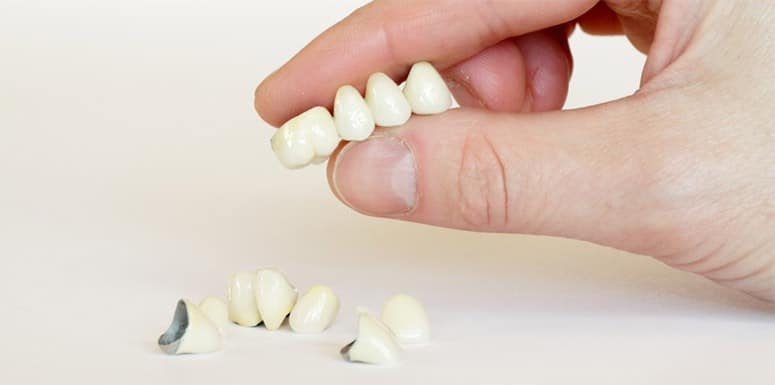Crowns, inlays and onlays are used to restore teeth damaged by decay or trauma. They are all slightly different, so when is each used and why?
To help you, we have put together a brief guide to crowns, inlays and onlays, explaining why we may suggest a particular option and how each could help your dental health. We will also take a quick look at the different materials that can be used so you can make an informed decision about your dental care.
What Is a Crown?
Also called a cap, a crown will cover up your entire tooth right down to the gum line, creating a tight seal that will prevent bacteria and infection from getting into the tooth. This can be a great option if you have a tooth that is substantially decayed and where it has lost a lot of its original structure.
When Might I Need a Crown?
We will suggest this option if you have very bad tooth decay or if your tooth is badly chipped. Crowns are also used to restore teeth after root canal therapy. In this case, using an inlay or onlay would not be strong enough. By covering up your entire tooth, we will restore its strength and structure so you can eat and talk normally and of course it will look beautiful. Crowns can also be used to support bridges, or can cover up dental implants.
What are Crowns Made From?
There is quite the choice of materials available as we can make what is called a porcelain fused to metal crown (PFM), where a precious metal alloy substructure is covered up with porcelain, or alternatively your new crown can be entirely metal free.
About PFMs and All-Ceramic Crowns
Both options will provide excellent results as our dental laboratory uses the most advanced porcelains and the shade of your new crown will be closely matched to your existing natural teeth. However, if you are replacing a front tooth then you may wish to consider an all-ceramic crown which will provide you with the very best aesthetic results. This is because the light can pass through the ceramic material in a way that is very similar to your natural teeth, closely replicating their translucency and liveliness and providing amazing results. Our all-ceramic crowns are very strong and long-lasting.
About Our Precious Metal Crowns
We can also make crowns from precious metal alloys. This might be a good choice for restoring a back tooth as they are strong and durable and only minimal tooth preparation is needed to create sufficient room for the crown. A precious metal alloy crown could be a more conservative option if you tend to grind your teeth or have a heavy bite. This is because gold is softer than porcelain and will be gentler on your opposing teeth and less likely to wear away your tooth enamel. Our precious metal crowns are polished to a high sheen to give them an attractive gold or silver colored appearance.
Making Your New Crown
You will need two appointments for a crown, as using local anesthetic we will carefully shape the damaged tooth, before taking a detailed impression that is used to hand-craft your new crown in our dental laboratory. It will be made to our exact prescription and will fit tightly over your tooth, providing maximum protection. Every crown is carefully designed to look incredibly natural, beautifully restoring your smile.
What Is an Inlay or Onlay?
We may suggest an inlay or onlay if you have a large cavity in the chewing surface of a back tooth, but where the damage is not sufficient to need a crown. It will fit tightly into the specially prepared cavity, preventing bacteria from getting into your tooth. Inlays are designed to repair just the central chewing surface of a back tooth, but onlays are slightly larger, repairing this central area plus one or more of the cusps. Your tooth cusps are the raised points you can see on the edges nearest to your cheeks and tongue and you typically have four cusps on a large molar. As onlays are a bit larger than inlays, they are sometimes called three-quarter or partial crowns, but unlike a full crown, some of your natural tooth will still be visible.
Making Your Inlay or Onlay
In order to have an inlay or onlay, we will remove all the damaged portion of your tooth, leaving the maximum amount of healthy tooth structure intact. Inlays and onlays are a much more conservative treatment compared to crowns, where we need to remove a substantial amount of tooth structure from all the tooth surfaces to prevent the crown from looking and feeling too bulky. Preparation is carried out using local anesthetic to keep you comfortable. The process to make an inlay or onlay is quite similar to making a crown, as this is a custom-made restoration using an impression taken of your newly prepared tooth.
What are Inlays and Onlays Made From?
Your new restoration can be made from porcelain or from composite resin. Both will look beautiful and are strong and durable. Porcelain restorations cost a little more, but are longer lasting and will not stain.
When you visit our dental office for treatment, we allow lots of time to discuss all options with you and are always happy to talk to you about your dental health. If you do not quite understand something then please just say as we will be more than happy to explain it again. Dental education is very important to us as we want you to feel happy with your choice of treatment. We will only suggest procedures we know will provide optimal and long-lasting results, restoring your dental health and your smile.
Request a no-obligation online quote


